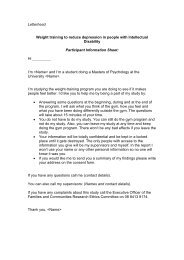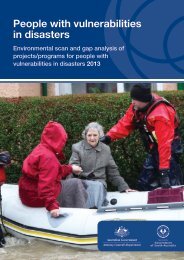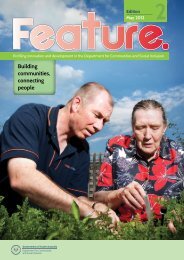Panyappi Indigenous Youth Mentoring Program Evaluation
Panyappi Indigenous Youth Mentoring Program Evaluation
Panyappi Indigenous Youth Mentoring Program Evaluation
You also want an ePaper? Increase the reach of your titles
YUMPU automatically turns print PDFs into web optimized ePapers that Google loves.
<strong>Panyappi</strong> <strong>Indigenous</strong> <strong>Youth</strong> <strong>Mentoring</strong> <strong>Program</strong> <strong>Evaluation</strong><br />
I think with <strong>Panyappi</strong> once they get him to this stage of the help, there should<br />
be a second stage of help for them when they leave. Help them to survive, keep<br />
on track with those kids so that they don’t get lost. It needs to go on. ( Family<br />
63<br />
member)<br />
Young people and families were not alone in their opinions on this. <strong>Program</strong> collaborators<br />
were concerned for the future of the program and the young people if the program was<br />
not available. They commented that the concept was excellent, but needed to be funded<br />
appropriately and over a sufficient length of time to allow the program to become<br />
established, offer job security to avoid losing staff, maintain continuity of support to<br />
young people, and for the mentoring role to be appropriately understood by program<br />
collaborators so there are reasonable expectations. They were confident that under<br />
these conditions ongoing evaluation of <strong>Panyappi</strong> would demonstrate outcomes with enough<br />
young people to substantiate those outcomes that had already been achieved.<br />
<strong>Program</strong> management themes<br />
Similarly to the young people and family themes, there is mutual influence between the<br />
themes named here. They reflect issues that typify the establishment and management<br />
of program initiatives that have uncertain futures beyond their initial funding grant.<br />
Establishing a new program<br />
It was apparent from talking with program collaborators, program funders and advisory<br />
group members that they appreciated the effort needed to establish a new program<br />
such as <strong>Panyappi</strong>. Many acknowledged that the program had a difficult start with three<br />
Coordinators to date and the second one leaving very suddenly. This had a negative<br />
impact on staff, resulting in them also leaving, and caused breaks in program continuity<br />
and mentor recruitment. Four months into the program the first Coordinator and MAYT<br />
management, who had a shared understanding of the program focus, were informed by<br />
program funders that they must maintain clearer distinctions between their client<br />
groups, with <strong>Panyappi</strong> having a strictly inner city focus on young people who may or may<br />
not be FAYS clients. This created problems in redefining auspicing arrangements (see<br />
below) and slowed the establishment process.<br />
<strong>Program</strong> funding was also not entirely secure, with a $90K shortfall that was not<br />
directly provided by FAYS as initially promised. FAYS decided to recover this through<br />
establishing most mentor positions as traineeships, reducing mentor numbers to 6 and<br />
removing car access. This was not a straightforward process and slowed program<br />
progress. It meant recruiting people with little or no experience in the workplace or in<br />
human services, resulting in the first Coordinator spending considerable time supporting<br />
and mentoring staff who did not always make good decisions in how to mentor young<br />
people or manage their time. The Coordinator often directly mentored young people to<br />
maintain support for them when mentors were inconsistent or tried to “save” the young<br />
63 This comment refers to the idea of providing support “beyond the trouble zone” as noted on<br />
page 18 in the “How <strong>Panyappi</strong> works” section.<br />
- 52 -












